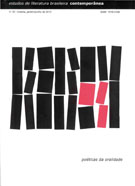O poder de denúncia do cordel no cinema:
O romance do vaqueiro voador, de João Bosco Bezerra Bonfim e Manfredo Caldas
Abstract
O filme O romance do vaqueiro voador, de Manfredo Caldas, é construído a partir do cordel homônimo de João Bosco Bezerra Bonfim ”“ que, por sua vez, foi inspirado no documentário Brasília segundo Feldman, de Vladimir Carvalho ”“ com a finalidade de contar, denunciar e lembrar a tragédia que foi a construção de Brasília. O artigo pretende discutir algumas questões: Por que escolher como personagem um poeta vaqueiro para perambular pelos lugares da tragédia? Por que utilizar um cordel para fazer surgir um outro filme?
References
BONFIM, João Bosco Bezerra (2004). Romance do vaqueiro voador. Brasília, LGE.
DEBS, Sylvie (2005). “Cordel e cinema”. In: Anthologie du cinéma brésilien des anneés 60 aux anneés 80: Glauber Rocha et Nelson Rodrigues. Bobigny. p. 100-05.
MATTOS, Carlos Alberto (2008). Pedras na Lua e pelejas no Planalto, Vladimir Carvalho. São Paulo, Imprensa Oficial. p. 216.
MELO NETO, João Cabral (1955). Morte e vida severina <http://www.culturabrasil.org/joaocabraldemelonetoo.htm.>
ROCHA, Glauber (1981). “Uma estética da violência”. In: Revolução do cinema novo. Rio de Janeiro. Alhambra/Embrafilme. p.28-33
Downloads
Published
Issue
Section
License
Authors who publish in this journal agree to the following terms:
a) The authors maintain the copyright and grant the journal the right of first publication, the work being simultaneously licensed under the Creative Commons Attribution License-Non Commercial 4.0 which allows the sharing of the work with acknowledgment of the authorship of the work and publication this journal.
b) Authors are authorized to enter into additional contracts separately, for non-exclusive distribution of the version of the work published in this journal (eg publish in institutional repository or as a book chapter), with authorship recognition and publication in this journal.
c) Authors are allowed and encouraged to publish and distribute their work online (eg in institutional repositories or on their personal page) after the editorial process, as this can generate productive changes, as well as increase the impact and citation of published work (See The Effect of Free Access).
d) The authors of the approved works authorize the magazine to, after publication, transfer its content for reproduction in content crawlers, virtual libraries and the like.
e) The authors assume that the texts submitted to the publication are of their original creation, being fully responsible for their content in the event of possible opposition by third parties.


